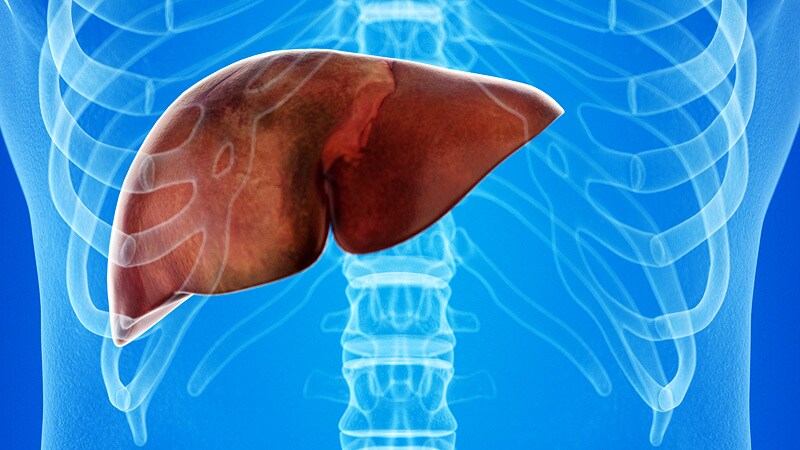Lanifibranor, a first-in-class pan-peroxisome proliferator-activated receptor (PPAR) agonist, has shown promise in the treatment of nonalcoholic steatohepatitis (NASH), an aggressive form of nonalcoholic fatty liver disease with few treatment options.
In a phase 2b, double-blind, randomized, placebo-controlled trial of patients with biopsy-proven NASH but no cirrhosis, significantly more patients taking once-daily 1200-mg lanifibranor (Inventiva Pharma) achieved the primary outcome.
The primary end point was a decrease of at least 2 points in the Steatosis, Activity, Fibrosis (SAF)-Activity score, without worsening of fibrosis. Resolution of NASH without worsening fibrosis — a key secondary end point — also occurred more often in patients taking lanifibranor.
“Lanifibranor tackles both metabolic drivers of the disease, most notably the adipose tissue dysfunction, as well as the mechanisms of inflammation and fibrogenesis inside the liver. It is a multi-targeted but balanced approach,” principal investigator Sven M. Francque, MD, PhD, Division of Gastroenterology and Hepatology, Antwerp University Hospital, Belgium, told Medscape Medical News.
The study was published online October 20 in The New England Journal of Medicine.
Study Details
The NATIVE study enrolled 247 patients with noncirrhotic, highly active NASH, of whom 103 (42%) had type 2 diabetes mellitus and 188 (76%) had significant (moderate) or advanced fibrosis. They were randomly allocated (1:1:1) to 1200 mg or 800 mg of oral lanifibranor or placebo once daily for 24 weeks.
The percentage of patients with a decrease of at least 2 points in SAF-A score was significantly higher in patients taking the 1200-mg dose of lanifibranor (55%), but not the 800-mg dose (48%), than among those taking placebo (33%).
The risk ratio for a response to 1200-mg lanifibranor vs placebo was 1.7 (95% confidence interval [CI], 1.2 – 2.3; P = .007). The risk ratio for a response to 800-mg lanifibranor vs placebo was 1.5 (95% CI, 1.0 – 2.1; P = .07).
The results favored both the 1200-mg and 800-mg doses of lanifibranor over placebo on several secondary end points. These included resolution of NASH without worsening of fibrosis (49% and 39%, respectively, vs 22%), improvement in fibrosis stage of at least 1 without worsening of NASH (48% and 34%, respectively, vs 29%), and resolution of NASH plus improvement in fibrosis stage of at least 1 (35% and 25%, respectively, vs 9%).
NASH is a “complex disease” in terms of pathophysiology, and “different targets need to be tackled simultaneously to have a substantial impact on the disease,” Francque told Medscape Medical News.
The pan-PPAR action of lanifibranor — targeting all three PAR isotypes — could explain why this drug hits both end points of NASH resolution as well as fibrosis regression, Francque added.
“These are stringent end points, with a high barrier, so achieving both holds promise for truly improving the patient’s prognosis,” he said.
Weight Gain an Issue?
Liver enzyme levels decreased and the levels of most lipid, inflammatory, and fibrosis biomarkers improved in the lanifibranor groups.
Diarrhea, nausea, peripheral edema, anemia, and weight gain occurred more frequently with lanifibranor than with placebo. No effect on kidney function or markers of bone turnover was observed.
The dropout rate for adverse events was less than 5% and was similar across the three groups.
Lanifibranor “looks like a highly efficacious drug…with a good safety profile,” and if confirmed in phase 3, “this would be a major breakthrough, as we currently haven’t seen any drug that has a significant effect on both steatohepatitis and fibrosis and this in the timeframe of 6 months,” Francque told Medscape Medical News.
In an editorial published with the study, Guadalupe Garcia-Tsao, MD, from the Digestive Diseases Section, Yale University School of Medicine, New Haven, Connecticut, says, “The availability of new therapies that are effective in ameliorating the histologic features in NASH, as shown by Francque et al., represents an invaluable opportunity.”
“The next step in the regulatory pathway for lanifibranor is a phase 3, double-blind, randomized, placebo-controlled trial with clinical benefit as an end point,” Garcia-Tsao points out.
Reached for comment, Jamile Wakim-Fleming, MD, who directs the fatty liver disease program at the Cleveland Clinic in Ohio, said NASH is a “rising etiology of liver disease, cirrhosis, and its complications, and it affects about 25% of the general population in the United States and worldwide.”
“There is a large need for drugs that prevent the development of this disease and its complications,” Wakim-Fleming, who was not involved in the study, told Medscape Medical News.
These phase 2b results with lanifibranor are “very welcoming and encouraging but should be interpreted with caution,” she said. “The side effects of lanifibranor in this trial were seen in 4% of the patients, notably concerning are the severe adverse events and the weight gain.”
“Weight loss is considered essential and first-line therapy in the management of NASH. Weight reduction surgeries are being done for that purpose when appropriate. Because of these side effects, more large and long-term trials are needed in order to clearly assess the safety of lanifibranor and the degree of weight gain when lanifibranor is used for more than 24 weeks,” Wakim-Fleming said.
Additionally, as noted by the authors, this study may be biased to the white population, the only population studied in the trial, “which does not represent the population at the highest risk for NASH, so the benefit still remains unclear,” she added. “The phase 3 trial is awaited.”
Disclosure forms for authors and editorialist are available at NEJM.org. Wakim-Fleming disclosed no relevant financial relationships. Inventiva Pharma funded the study and paid for professional writing assistance and copyediting.
N Engl J Med. Published online October 20, 2021. Abstract, Editorial
For more news, follow Medscape on Facebook, Twitter, Instagram, YouTube, and LinkedIn.
